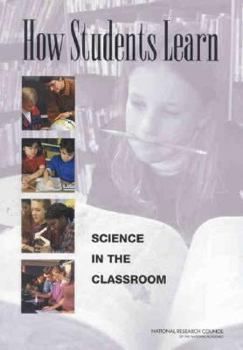How Students Learn: Science in the Classroom
How Students Learn: Science in the Classroom builds on the discoveries detailed in the best-selling How People Learn . Now these findings are presented in a way that teachers can use immediately, to revitalize their work in the classroom for even greater effectiveness. Organized for utility, the book explores how the principles of learning can be applied in science at three levels: elementary, middle, and high school. Leading educators explain in...
Format:Paperback
Language:English
ISBN:0309089506
ISBN13:9780309089500
Release Date:January 2005
Publisher:National Academies Press
Length:264 Pages
Weight:1.25 lbs.
Dimensions:0.7" x 7.1" x 10.0"
Customer Reviews
2 ratings
How Students Learn mathematics
Published by Thriftbooks.com User , 15 years ago
This is a great book that focuses on how students learn mathematics. The only reason I am not giving it 5 stars is it's difficult to read. The examples are great but the regular text uses words in such a way that you have to keep rereading. Unless you are the type of person that is comfortable with small and technical writing you will not enjoy reading this book. The book also provides a CD that focuses on Social Studies and Science.
Concise and Useful Approached to Teaching
Published by Thriftbooks.com User , 19 years ago
How Students Learn: History, Mathematics, and Science in the Classroom by M. Suzanne Donovan, John D. Bransford (National Academies Press) This book has its roots in the report of the Committee on Developments in the Science of Learning, How People Learn: Brain, Mind, Experience and School (National Research Council, 1999, National Academy Press). That report presented an illuminating review of research in a variety of fields that has advanced understanding of human learning. The report also made an important attempt to draw from that body of knowledge implications for teaching. A follow-on study by a second committee explored what research and development would need to be done, and how it would need to be communicated, to be especially useful to teachers, principals, superinten¬dents, and policy makers: How People Learn: Bridging Research and Prac¬tice (National Research Council, 1999). These two individual reports were combined to produce an expanded edition of How People Learn (National Research Council, 2000). We refer to this volume as HPL. In the present book, the goal is to take the HPL work to the next step: to provide examples of how the principles and findings on learning can be used to guide the teaching of a set of topics that commonly appear in the K-12 curriculum. As was the case in the original work (1999), the book focuses on three subject areas: history, mathematics, and science. Each area is treated at three levels: elementary, middle, and high school. Distinguished researchers who have extensive experience in teaching or in partnering with teachers were invited to contribute the chapters. The committee shaped the goals for the volume, and commented-sometimes extensively-on the draft chap¬ters as they were written and revised. The principles of HPL are embedded in each chapter, though there are differences from one chapter to the next in how explicitly they are discussed. Taking this next step to elaborate the HPL principles in context poses a potential problem that we wish to address at the outset. The meaning and relevance of the principles for classroom teaching can be made clearer with specific examples. At the same time, however, many of the specifics of a particular example could be replaced with others that are also consistent with the HPL principles. In looking at a single example, it can be difficult to distinguish what is necessary to effective teaching from what is effective but easily replaced. With this in mind, it is critical that the teaching and learning examples in each chapter be seen as illustrative, not as blueprints for the "right" way to teach. We can imagine, by analogy, that engineering students will better grasp the relationship between the laws of physics and the construction of effec¬tive supports for a bridge if they see some examples of well-designed bridges, accompanied by explanations for the choices of the critical design features. The challenging engineering task of crossing the entrance of the S






